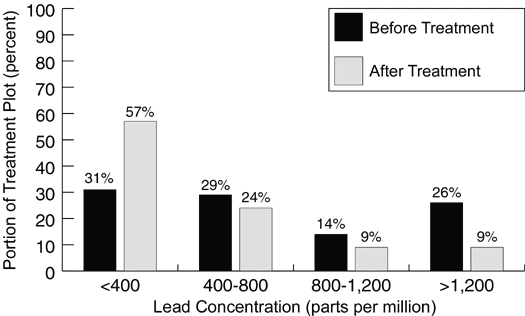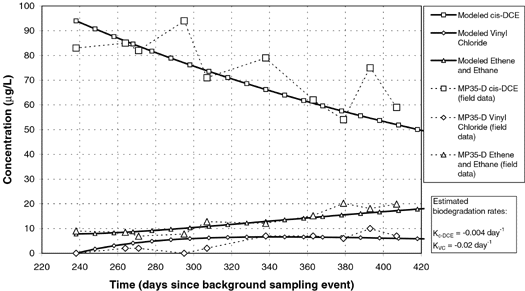|
August 1999 Phytotechnology for Metal-Contaminated Surface Soilsby Steven Rock, EPA National Risk Management Research Laboratory The use of phytoextraction to remediate surface soils contaminated with metals was demonstrated recently at the Magic Marker site in Trenton, NJ. Preliminary results of the demonstration, which took place between May 1997 and November 1998 under EPA’s Superfund Innovative Technology Evaluation Program, indicate that specially selected plants successfully accumulated significant amounts of lead and other metals. Comparison of post-treatment soil concentrations to baseline soil concentrations indicated an average 20 percent reduction of lead in the top 15.2 centimeters of soil. Contamination at the Magic Marker site resulted from various manufacturing activities, including lead-acid battery production, that were conducted between 1947 and 1987. The site soil consisted of gravelly sand with miscellaneous debris. Earlier investigations identified lead in the surface soils exceeding the regulatory limit for residential areas (400 parts per million). The demonstration evaluated a total of three crops grown in a 9.1- by 17.4-meter treatment plot, compared against a 9.1- by 12.2-meter control plot. Two crops of Brassica juncea (Indian Mustard) plants were grown and harvested over the spring and summer of 1997. One crop of sunflower plants was grown in the summer of 1998. Harvested plant tissue samples were collected to evaluate the amount of lead uptake in each crop. Prior to the first crop plant and immediately following harvest of the third crop, soil samples also were collected to evaluate the change in lead concentrations in the root zone. To solubilize the metals into a form that the plant tissues could absorb, and consequently increase the efficiency of phytoextraction, ethylenediaminetetra-acetic acid and other amendments were added to the soil. Figure 1 shows the distribution in soil lead concentration before and after phytoextraction was applied. Results show that treatment increased the portion of the treatment area with lead concentrations below 400 mg/Kg from 31% to 57%. The average lead concentrations accumulated in the above-ground plant tissue samples from the two Brassica crops were 830 mg/Kg and 2,300 mg/Kg. (These differences in lead uptake between the two Brassica crops are attributed to amendment optimization.) Lead in the above-ground plant tissues of the sunflowers was measured at an average concentration of 400 mg/Kg. All three of these average values exceeded the minimum project objective of 200 mg/Kg (dry weight). This demonstration confirmed earlier findings that the use of Indian Mustard plants to extract metals is most applicable to intermediate levels of lead contamination (less than 1,500 mg/Kg), soil pH levels of 4.3-8.3, and moderate climates.
EPA researchers estimate that phytoextraction for soils covering a 10-acre site typically requires 6-8 crops over three growing seasons. Harvesting of this quantity of crop is anticipated to ultimately result in the disposal of approximately 500 tons of biomass from 0.3 meters of top soil. This represents 0.25% of the 20,000 tons of contaminated soil that otherwise would require excavation and landfilling. For more information, contact Steven Rock (EPA National Risk Management Laboratory) at 513-569-7149 or E-mail rock.steven@epa.gov. Sequential Anaerobic/Aerobic In Situ Treatment Systemby Craig Lizotte, Envirogen, and Andrew Hoffman, State of New Hampshire, Department of Environmental Service Early results of a pilot-scale enhanced bioremediation project operating at a former municipal landfill site in Dover, NH, since January 1998 are demonstrating that enhanced degradation of contaminants is occurring. The project involves the sequential use of anaerobic treatment to degrade chlorinated volatile organic compounds (VOCs) and aerobic treatment for non-chlorinated VOC degradation and arsenic immobilization. This demonstration was undertaken to evaluate the effectiveness of enhanced bioremediation as an alternative to the more costly construction of a landfill cap and leachate pump and treat system (which are required in the site’s existing record of decision) and to obtain necessary design data for possible full-scale implementation. Although contaminant concentrations site-wide have decreased naturally over time, the treatment zone is located in an area that exhibited the greatest diversity and some of the highest levels of contaminants remaining at the site. The precise location, orientation, and design of the treatment zone were selected based on the results of ground water quality data, hydrogeologic investigations, and treatability testing. The aquifer is found in overburden materials of sand with silt clay lenses. Located at the toe of the landfill, the treatment zone consists of a 61- by 91-meter area with two amendment injection systems. The anaerobic system, which constitutes the first 46-61 meters of the gradient, was designed to add electron donor compounds for enhancement of chlorinated compound degradation. Following laboratory testing, sodium benzoate was selected to serve as the electron donor, at a target application level of 3.7 mg/L. The aerobic system, which is located hydraulically downgradient from the anaerobic area, completes the final 30-45 meters of the gradient within the treatment zone. Gaseous oxygen is injected at a series of injection points to achieve a dissolved oxygen target concentration of 2 mg/L in the aerobic zone. Preliminary data collected from selected monitoring points in the anaerobic zone indicate that enhanced biodegradation rates for cis-1,2-dichloroethene (DCE) and vinyl chloride could be as high as 4 x 10-3 day-1 and 2 x 10-2 day-1, respectively (Figure 2). Prior to the demonstration, anaerobic biodegradation rates in this area were approximately zero.
Data on aerobic biodegradation rates will be collected and analyzed over the next 6 to 12 months. Although arsenic was to be a target for removal in the aerobic zone through co-precipitation with iron, data indicate that arsenic generally is being immobilized in the anaerobic portion of the treatment zone. In most locations, arsenic is entering the anaerobic zone at levels in the range of 50-200 ppm and leaving at concentrations below the interim cleanup level of 50 ppm. It is believed that co-precipitation with sulfides is the mechanism for arsenic removal in the anaerobic zone. This bioremediation demonstration is anticipated to continue through the year 2001. For more information, contact Craig Lizotte (Envirogen) at 781-821-5560 or E-mail lizotte@envirogen.com, or Andrew Hoffman (State of New Hampshire, Department of Environmental Services) at 603-271-6778 or E-mail a_hoffman@des.state.nh.us.
Bioventing for Enhanced Degradation of PAHsby Paul McCauley, Ph.D., U.S. EPA National Risk Management Research Laboratory Pilot-scale testing of an aerobic bioventing process for enhanced degradation of polynuclear aromatic hydrocarbon (PAH) contaminants in soil has been completed at the Reilly Tar site in St. Louis Park, MN. Demonstration results show that continuous, slow injection of atmospheric air into the soil subsurface can stimulate the growth of indigenous microorganisms capable of contaminant consumption. After almost five years of treatment, bioventing reduced the total PAH concentrations at the treatment plot by 37 percent, while the reduction in PAH concentration at the control plot was only 11 percent. Between 1917 and 1972, the 80-acre Reilly Tar site was used for coal tar distillation and wood preserving operations. Wood preserving solutions were estimated to consist of 60-70 percent creosote oil and petroleum oils. Soils at this site consist of approximately 0.6 meters of a topsoil cover underlain by an asphaltic layer, below which coarse sand extends to the water table at approximately 3 meters below ground surface. Sandy soils within the demonstration area were contaminated with PAHs in concentrations as high as 873 mg/Kg. The simple bioventing process used at the Reilly Tar site consisted of a single, 5-cm injection well surrounded by a network of four tri-level soil gas/soil temperature monitoring stations and a piezometer. The screened injection well was installed in the center of the 15.2 meter-square treatment area, and connected to a nearby 2.5-horsepower blower capable of injecting air at a rate of 0.3-5.7 m3/hour. During installation and after shutdown of the system, 120 soil cores were collected from each plot at a depth of 1.2-2.4 meters. Respiration tests conducted after two years of system operation suggested that initial oxygen utilization correlated to concentration reductions in the more readily degradable carrier oils (23 percent for naphthalene). Concentrations of the three- and higher-ring PAHs, however, remained unchanged. Final soil data collected in 1997 after five years of treatment showed that bioventing significantly treated the higher-ring PAHs as well. Data analysis indicated concentration reductions of 62 percent, 50 percent, 31 percent, 20 percent, and 24 percent for the 2, 3, 4, 5, and 6-ring PAHs, respectively. These numbers may change after further evaluation, but any changes would be minimal and are not expected to alter the project conclusions. This demonstration also confirmed earlier understanding of the applicability of aerobic bioventing technology to degrade high-molecular weight hydrocarbons in situ in vadose zone soils. Suitable soil conditions include:
Final project details will be available this Fall through EPA’s Superfund Innovative Technology Evaluation (SITE) Program, which sponsored the demonstration. Contact Dr. Paul McCauley (EPA National Risk Management Research Laboratory) at 513-569-7444 or E-mail mccauley.paul@epa.gov for additional information. |
|
|
|









